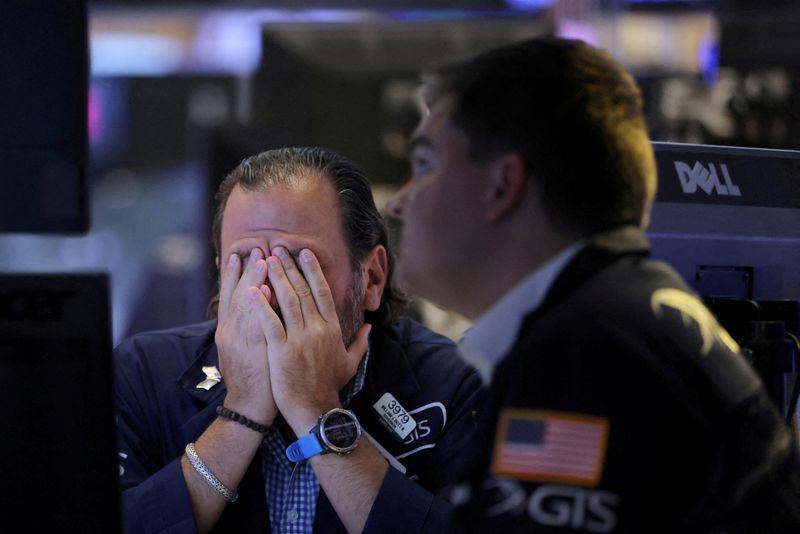By David Randall
NEW YORK (Reuters) - Investors believe the feedback loop between U.S. stocks and bonds will likely be a key factor in determining whether the gyrations that have rocked markets this year continue into the last months of 2022.
With the third quarter over, both assets have seen painful sell-offs - the S&P 500 is down nearly 25% year-to-date and the ICE (NYSE:ICE) BofA Treasury Index has fallen by around 13%. The twin declines are the worst since 1938, according to BoFA Global Research.
Yet many investors say bonds have led the dance, with soaring yields slamming stock valuations as market participants recalibrated their portfolios to account for stronger-than-expected monetary tightening from the Fed.
The S&P 500’s forward price-to-earnings ratio fell from 20 in April to its current level of 16.1, a move that came alongside a 140 basis point surge in the yield on the benchmark U.S. 10-year Treasury, which moves inversely to prices.
"Interest rates are at the core of every asset in the universe, and we won’t have a positive repricing in equities until the uncertainty of where the terminal rate will settle is clear,” said Charlie McElligott, managing director of cross-asset strategy at Nomura.
Volatility in U.S. bonds has erupted in 2022, with this week’s Treasury yield gyrations taking the ICE BofAML U.S. Bond Market Option Volatility Estimate Index to its highest level since March 2020. By contrast, the Cboe Volatility Index - the so-called Wall Street "fear gauge" - has failed to scale its peak from earlier this year.
“We have emphasized ... that interest rate volatility has been (and continues to be) the main driver of cross-asset volatility. Nevertheless, even we continue to watch the rates volatility complex with incredulity,” analysts at Soc Gen wrote.
GRAPHIC: Bonds break down - https://fingfx.thomsonreuters.com/gfx/mkt/akpezdaxjvr/Pasted%20image%201664460769205.png
Many investors believe the wild moves will continue until there is evidence that the Fed is winning its battle against inflation, allowing policymakers to eventually end monetary tightening. For now, more hawkishness is on the menu.
Investors on Friday afternoon were pricing in a 57% chance that the U.S. central bank hikes rates by 75 basis point rates at its Nov. 2 meeting, up from a 0% chance one month ago, according to CME's FedWatch tool. Markets see rates hitting a peak of 4.5% in July 2023, up from 4% a month ago.
Next week’s U.S. employment data will give investors a snapshot of whether the Fed’s rate hikes are starting to dent growth. Investors are also looking to earnings season, which starts in October, as they gauge to what degree a strong dollar and supply chain snafus will affect companies’ profits.
For now, investor sentiment is largely negative, with cash levels among fund managers near historic highs as many increasingly choose to sit out the market swings. Retail investors sold a net $2.9 billion of equities in the past week, the second largest outflow since March 2020, data from JPMorgan (NYSE:JPM) showed on Wednesday.
Still, some investors believe a turnaround in stocks and bonds may soon come into view.
The deep declines in both asset classes make either an attractive investment given the likelihood of longer-term returns, said Adam Hetts, global head of portfolio construction and strategy at Janus Henderson Investors.
"We've been in a world where nothing was working. Most of that agony is over, we think," he said.
JPMorgan’s analysts, meanwhile, said high cash allocations may provide a backstop for both equities and bonds, likely limiting future downside.
At the same time, the fourth quarter is historically the best period for returns for major U.S. stock indexes, with the S&P 500 averaging a 4.2% gain since 1949, according to the Stock Trader's Almanac.
Of course, dip buying has fared poorly this year. The S&P 500 has mounted four rallies of 6% or more this year, with each rebound sputtering out to be followed by fresh bear market lows.
Wei Li, Chief Investment Strategist at BlackRock (NYSE:BLK) Investment Institute, believes more jumbo rate hikes from the Fed may dent growth, while a slower pace of tightening could hurt bonds by making inflation more entrenched.
She is underweight developed market equities and fixed income, believing that “difficult choices” faced by central banks will spur more market ructions.
Equities may have further to fall than bonds given the high likelihood of a recession in 2023, said Keith Lerner, co-chief investment officer and chief market strategist at Truist Advisory Services.
"We think the upside for equities will be capped because there will be more earnings pain and more central bank tightening," he said.
